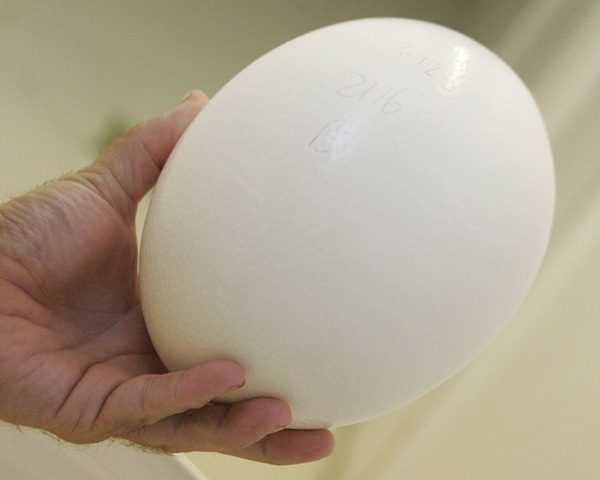
Roaming Acres Ostrich Farm, Lafayette/Hardyston
An ostrich is a strange-looking creature. It stands 6 to 9 feet tall and weighs 150 to 270 pounds. Its spindly neck and spindly legs with two-toed feet connect to a ruffled midsection that makes it look like a bulbous ballet dancer in a tutu. Stranger still is ostrich behavior. At Roaming Acres, I’m watching a group of them dash across a field at top speed. Suddenly they stop short, trot over to the fence where I stand, and poke their pink beaks and brown saucer eyes between the slats to investigate.
Todd Appelbaum, who owns Roaming Acres, is used to ostrich quirks. He says its 300 to 400 birds make it the largest ostrich farm east of the Mississippi. He casually brushes past a flock of adults who have gathered to watch him repair a fence. Later he shoos away a gaggle of week-old chicks to adjust the temperature in their corrugated shed so it holds steady at a cosseting 80 degrees.
On this farm that Appelbaum, 41, built and operates almost entirely on his own, ostriches are not a curiosity, but an environmentally sustainable livelihood. “We utilize everything on the animal,” he says. “The meat, the eggs, the hides for small wallets and organizers, the bones and tendons for dog treats. We have someone turning the rendered fat into soap oils. Even the feathers can be used for dusters.” He also keeps 15 emus for the hefty eggs they lay, which are prized as delicacies (he can sell them for about $25 each) and about 50 Berkshire hogs for their meat.
Each evening, Appelbaum harvests the fertilized eggs from the ostrich nests. He rests the eggs in a cool place for a week, partly so the birds don’t inadvertantly crush them. Then he transfers them to incubators in the former dairy barn at the top of the hilly property. After 42 days, he moves the eggs to two hatcheries, where the chicks arduously peck and claw their way out of the thick shells, usually within a day or two. He’ll help them if they’re having trouble.
The birds reach maturity in 12 months, at which point they require only unheated shelter and are allowed to roam the 69 acres fairly freely. Appelbaum harvests about 400 to 500 a year, trucking them himself to the USDA meat-processing plant in Washington Township. He sells about 10 a year to be exhibited at zoos, including the Bronx Zoo and Philadelphia Zoo and ones as far away as Ohio, Illinois and Indiana.
Ostriches are considered omnivores. In the wild, they eat mostly plant matter, but will feed on insects, small lizards and frogs if available. Appelbaum feeds them a vegetarian diet he makes from soybean meal and alfalfa hay from neighboring farms.
Though Applebaum grew up in suburban Paramus, his father always kept horses on their property, spurring his interest in farming at an early age. He thought about raising cattle, but liked the more labor-intensive challenges of exotic birds.
“I wanted to do something different,” he says. “Something healthy that would give customers an alternative to factory-farmed meats.” Appelbaum notes that ostrich meat has far less fat and calories than beef, pork or even chicken. He says he plans to open a retail shop at the farm this year; for now he makes most of his sales at farmers’ markets in New York City and Montclair.
Last fall at the market in Philadelphia’s Rittenhouse Square, a couple bought a dried ostrich tendon for their dog, and Kim Brosnan-Myers, a teacher, took home a thick-shelled ostrich egg to show her Montessori class.
“We paint a life-sized ostrich on the wall and make ostrich eggs out of papier mâché,” she said, cradling the big, cream-colored egg. “But there’s nothing like showing them the real thing.” 65 Big Spring Rd, 973-202-9344, roamingacres.com.
